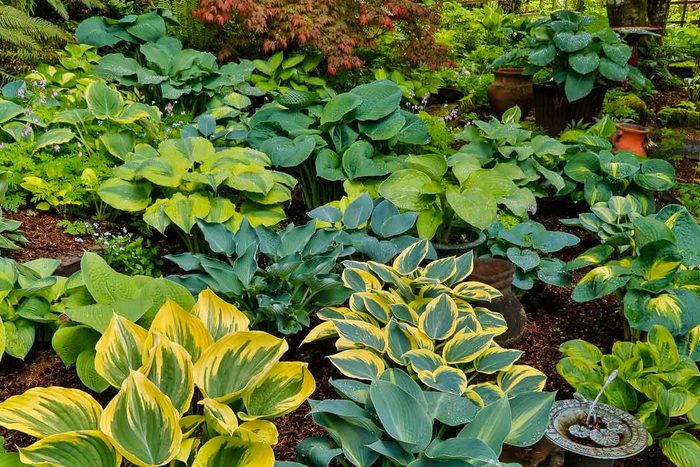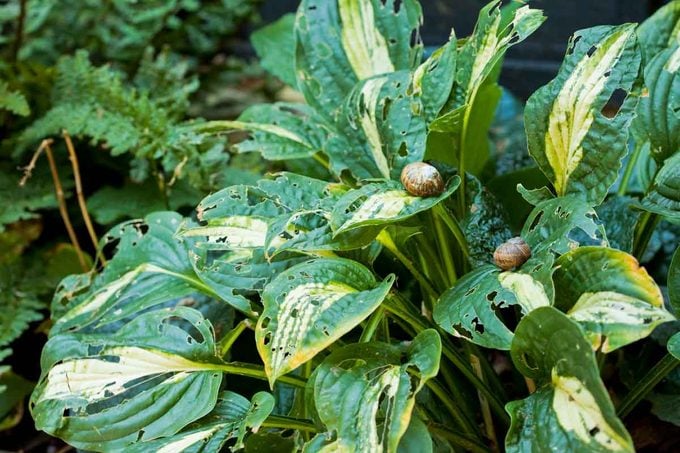11 Common Mistakes People Make When Planting Hostas
Updated: Apr. 12, 2023

Hostas are an easy landscaping plant, so hosta care is often taken for granted. Here are 11 of the most common mistakes gardeners make when growing hostas.
Anyone with a shady spot to fill can attest to the value of hostas. They’ll happily grow where other plants fail. To ensure your hostas thrive, avoid these common hosta growing mistakes:
On This Page
Ignoring Slugs on Hostas

Slugs and snails view hostas as an invitation to the buffet table. Thick-leaved hostas are more resilient, but damage can still occur. Fortunately, there are some simple precautions you can take to keep slugs and snails from attacking your hostas. Take action immediately if you find slugs on hostas.
Overlooking Protection From Deer
Hostas have been called deer candy. Where deer are prevalent, the plants will need protection. So, how to keep deer from eating hostas? You can spray them with an animal repellent or install physical barriers. Some people keep deer away with a perimeter of string or fishing line; when the deer run into it unexpectedly, it scares them and they run off. Just mark the lines so pedestrians see them and don’t trip.
Growing Too Many Hosta Varieties
Planting one of each hosta variety may please the plant collector, but it won’t please the visual senses. It’s not how nature operates, and the resulting artificial look appears unattractive at best, jarring at worst. Hostas (and many other plants) look more natural when grouped in odd numbers. Careful grouping will give your hosta landscaping design a cohesive look.
Going Overboard With Variegated Hostas
Too many variegated hostas make the garden look spotty. It’s better to plant in moderation and in small drifts rather than scattershot. For best effect, surround the variegated hostas with more subtle-colored hostas of green and blue-green.
Pairing the Wrong Hosta Varieties
Planting hostas with white variegation next to hostas with gold variegation is a visual no-no. The two compete with each other and look unnatural together.
Dividing or Transplanting Hostas at the Wrong Time
Hostas should be divided every four to five years. Spring is the best time to divide or transplant hostas. Wait until plants are just starting to emerge (they’re easier to spot this way), then dig up, divide and replant. Temperatures are cooler in the spring and the foliage hasn’t developed yet, so plants won’t be water stressed.
Growing Hostas in an Exposed Location
Because hostas replicate so easily, some gardeners presume they can stick them anywhere. They shouldn’t. Planting in an open, exposed location can lead to tattered foliage. Try to find a spot with protection from wind. While you’re at it, if you have children or a dog, think about planting hostas where they’ll get protection from trampling, too.
Planting Hostas in Sun
Hostas are shade-loving plants. They’ll do well in full shade or where they get some morning sun, which is less harsh. Too much sunlight causes leaves to scorch and bleach out. Hostas like even moisture, too, which is another reason sunny spots don’t work — they tend to dry out faster. So if you’re looking for drought-tolerant plants, hostas might not be the right choice.
Overcrowding Plants
Although it’s tempting to plant hostas closely for a mature look, it’s not good for them. Overcrowding impedes their growth, and reduced air circulation can lead to foliage problems. Space plants according to plant tag directions. And be prepared to divide hostas as needed.
Growing Hostas With the Wrong Companions
Hostas look best with fine-textured companion plants because the foliage contrasts with their large, boldly textured leaves. Examples include ferns, bleeding heart, astilbe and false spirea.
Ignoring Size When Siting a Plant
Hosta varieties have different mature sizes. A large hosta measuring 24 inches at maturity can serve as a garden focal point and be enjoyed from a distance. A smaller variety should be grouped with others for more visual interest. Size also affects placement — those small hostas can go in front, where the large focal point hosta would be better in the background.